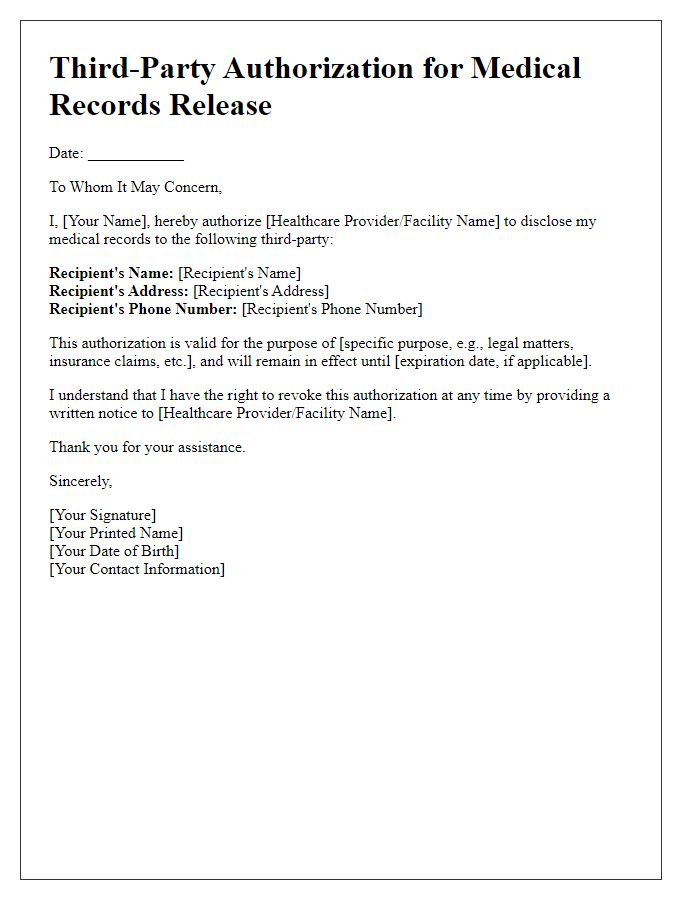Are you looking to give someone the authority to act on your behalf? A third-party authorization letter is a handy tool that can simplify processes like legal matters, financial transactions, or medical decisions. This template will guide you in crafting a clear and concise letter that ensures your trusted individual has the right permissions. Curious to learn how to structure this important document? Let's dive in!

Clarity of Authority Granted
A third-party authorization grants a specified individual or entity the legal capacity to act on behalf of another in certain matters, such as financial transactions or medical decisions. This document outlines the precise scope of the authority being delegated, often including details like the names of all parties involved, the specific tasks the third party is allowed to undertake, and the duration of the authorization, which may be limited to particular dates or events. Clarity in the wording prevents misunderstandings, ensuring the authorized representative understands their responsibilities and limitations. Additionally, providing contact information for both the granting party and the authorized individual fosters transparency and accountability, making it easier for institutions, such as banks or hospitals, to verify the authorization's legitimacy.
Precise Identification of Parties Involved
A third-party authorization enables designated individuals or entities to act on behalf of another party in specific matters. The precise identification of parties involved is crucial for the process. This includes full legal names, addresses, and contact information of the individual granting authorization, referred to as the "Principal," and the authorized individual or entity, known as the "Agent." Additionally, relevant identification numbers such as Social Security Number, tax identification number, or business license number should be included for clarity and verification purposes. Specifying the purpose of the authorization, including any limitations, is essential to ensure all parties understand the scope of the authority being granted.
Specific Scope and Duration of Authorization
Third-party authorization is a legal mechanism that permits individuals or organizations to act on another person's behalf. This process often involves specific details regarding the scope, duration, and limitations of the authority granted. For instance, in the context of medical affairs, a patient may authorize a family member to discuss their medical history with healthcare providers for a specified duration, such as six months, ensuring confidentiality while allowing necessary communication. In financial contexts, someone may authorize an accountant to access bank statements for tax preparation purposes, outlining access to specific accounts and restricting transactions. Precise definitions of duties and limits enhance clarity and mitigate risks while ensuring that transactions are completed efficiently and legally.
Legal Compliance and Language
Third-party authorization is crucial for ensuring legal compliance in various transactions. This document allows designated representatives (the third party) to act on behalf of an individual or organization in legal matters, such as financial transactions or data access. Essential elements include clear identification of the authorized parties, specific powers granted (for example, handling financial affairs or accessing confidential information), and limitations on authority. Language used must be precise to prevent misunderstandings; legal terms must be clearly defined. Important jurisdictions, such as local, state, and federal laws, should be considered to ensure validity. Consideration of the context, including specific documents, numbers, and relevant parties, can enhance the effectiveness of the authorization.
Contact Information for Verification
Third-party authorization enables designated individuals or organizations to access or manage accounts on behalf of another person. This process often involves providing contact information for verification purposes, allowing service providers to confirm the identity and legitimacy of the request. Essential elements typically include the primary account holder's name (John Doe), their account number (123456789), and the contact details of the authorized person (Jane Smith, email: jane.smith@example.com, phone: (555) 123-4567). Including these details ensures compliance with regulations, safeguarding sensitive information while streamlining communication and access. Providing accurate verification data facilitates a smoother authorization process, enhancing security and trust between all parties involved.
Letter Template For Third-Party Authorization Samples
Letter template of third-party authorization for medical records release

Letter template of third-party authorization for employment verification












Comments